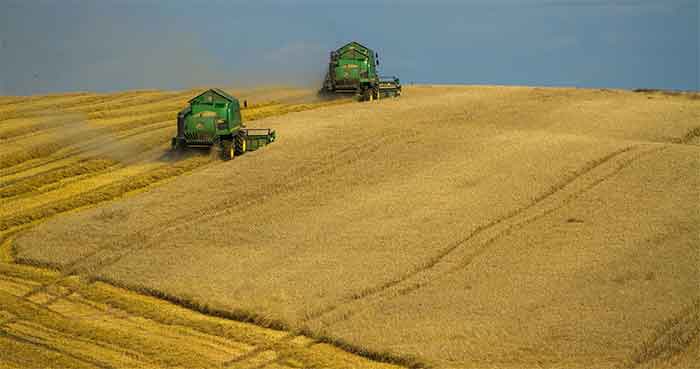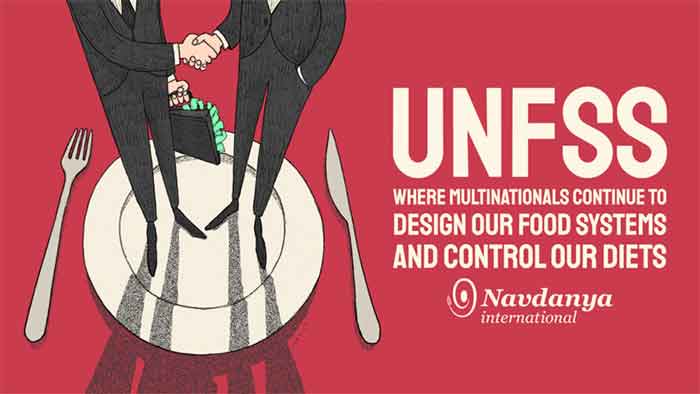
At a time when increasing questions about corporatization trends are being raised in India, it is useful to know that the extent of corporate control over farming and farmers ( small and medium farmers, family farms) is being increasingly questioned almost all over the world, including the USA. A widely discussed account is that of Bedabrat Pain , an ex-NASA scientist who recently travelled the US countryside widely with three colleagues to understand the reality of corporate control and the resulting problems of small farmers and family farms. The quotes here are from his report titled ‘How Big Ag Ate Up America’s Small farms’.
This report says “Nearly all the farmers we talked to held the Reagan-era ‘opening up’ of agriculture and the rise of ‘Big Ag’ –gigantic agro-business that now dominate American farming –responsible for their plight…Shorn of government support a quarter million small farmers closed , over a million generational farmers were displaced, and deserted towns began dotting the rural landscape. What happened to the land? Unsurprisingly Big Ag gobbled it up as landless farmers started toiling under onerous contract farming terms. Giant corporations used financial clout to control the market, depress farm-gate prices, buy infrastructure for a song, and raise costs to a point where small farms became unsustainable.”
This account would no doubt shock many people who have generally a benevolent and picturesque view of US farming. But at the same time let us also remember that the US is not at all alone in experiencing a large-scale displacement and closing down of small farms. The figure mentioned for a smaller neighboring country Mexico is that nearly a million farmers were displaced in the aftermath of the introduction of trade treaty called NAFTA which brought cheap subsidized imports from the USA against which Mexican farmers could not compete.
Or take the example of India where comparison of 2001 and 2011 census data reveals a reduction of 8.6 million farmers and even a bigger rise in the number of rural landless households. So while we are shocked at what happened in USA let us look at our own plight as well.
In the account on USA changes it is said that most farmers believe that harmful impacts related more to legal changes made in Reagan years. This again bears comparison with the debate taking place now in India regarding the impact of three new farm laws against which farmers’ movement, supported by several others, has been protesting.
However other studies relating to US agriculture and the adversities of small farmers point to several much longer-term trends as well. What happens is that when there is a lot of opposition to some very adverse recent changes like laws, the longer term problems tend to be forgotten or neglected in relation to this. This is what is reflected in the above account on the USA which traces problems entirely to Reagan-era changes while the corporatization trends of earlier years too were problematic. Again there is similarity with the situation in India, where the intense debate just now on the three farm laws has led to the neglect of several disturbing trends from much earlier times.
Returning to the USA account quoted above it is useful to see what it says about the extent to which corporate control has proceeded. To quote, “ A handful of meat processing companies now own the livestock , while poultry , beef and pig farmers are more or less serfs—raising the animals for them under contract . They have no bargaining power because these food giants are the only players left in town. Nearly 75% of all US poultry farmers today live below the poverty line while Big Ag control everything from “ farm to fork” and from seeds to grocery stores. Four large firms control at least two-thirds of the seed market , 80% of chemical fertilizers , grain trading , dairy production , meat supply ad almost 100% of farm machinery. Meanwhile , government money flows to the corporations in the form of write-offs, market facilitations and crop insurance subsidies. Over 70% of the $50 billion in US government subsidies goes to the top 20% of farms. John E. Ikerd, retired professor emeritus at University of Missouri, says this couldn’t have happened without political patronage.”
This is a very disturbing picture which shows that domination of a few big corporations is accompanied by increasing marginalization and disempowerment of farmers till they are reduced to serf-like position in contract farming or under somewhat similar legal arrangements. This entire disturbing and harmful trend is manipulated in such a way that the big business interests continue to get the most financial benefits from government spending on agriculture.
This complaint has been increasingly heard in many countries that a very large share of what gets spent in the name of agriculture actually goes to big agro-business and not to the small and medium farmers who most need this help and support.
The wider reality is that with all these injustices of the USA or western countries there are likely to be social security arrangements that will protect the most marginalized sections from the worst impacts of poverty , but such protection is likely to be denied to the marginalized and disempowered or even displaced sections in poorer or less prosperous countries including India.
Hence it is clear that one of the most urgent but neglected issues is not just increasing agricultural production but increasing it on sustainable and protected farms of small and medium farmers so that the base of agriculture all over the world is that of small and medium farmers. This is an important justice issue, but in addition it should be highlighted that small and medium farmers alone are able to provide the care of soil and land and animals and water sources which is so essential for sustainability and which cannot be provided by the big business farming with all its heavy machines and truckloads of agro-chemicals.
Bharat Dogra is a journalist and author. His recent books include Man Over Machine and Protecting Earth for Children.
GET COUNTERCURRENTS DAILY NEWSLETTER STRAIGHT TO YOUR INBOX














































